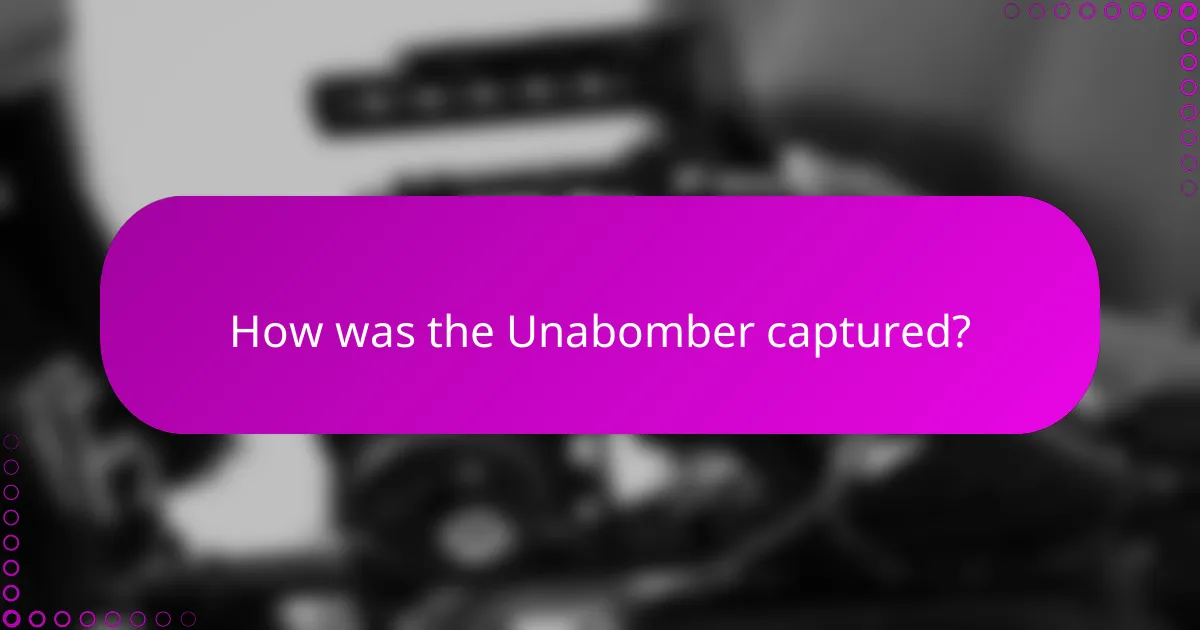The Unabomber, Theodore John Kaczynski, is an American domestic terrorist known for a nationwide bombing campaign from 1978 to 1995 that targeted individuals connected to modern technology and industrial society, resulting in three deaths and 23 injuries. His manifesto, “Industrial Society and Its Future,” critiques technological advancement and has sparked significant discussions regarding its societal impact. Kaczynski’s background, including his early intellectual achievements and isolation in Montana, contributed to his radicalization and violent actions. His eventual capture in 1996 followed a lengthy investigation aided by public assistance, marking a pivotal moment in law enforcement’s efforts to address domestic terrorism. This article will analyze Kaczynski’s manifesto, explore his background, and detail the techniques used for his capture.

What is the Unabomber and why is he significant?
The Unabomber is the nickname given to Theodore John Kaczynski, an American domestic terrorist. He is significant for conducting a nationwide bombing campaign from 1978 to 1995. Kaczynski targeted individuals associated with modern technology and industrial society. His actions resulted in three deaths and 23 injuries. He evaded capture for nearly 17 years. Kaczynski’s manifesto, titled “Industrial Society and Its Future,” critiques technological advancement. This document gained widespread attention and sparked debates about technology’s impact on society. His case raised important discussions about mental health and radical ideologies.
What events led to the emergence of the Unabomber?
The emergence of the Unabomber, Ted Kaczynski, was influenced by several key events in his life. His early intellectual development included attending Harvard University at age 16. Kaczynski later became increasingly isolated and disillusioned with modern society. He retreated to a remote cabin in Montana in 1971, where he lived without electricity or running water. During this time, he began formulating his anti-technology ideology. Kaczynski’s first bomb was sent in 1978, marking the start of his bombing campaign. Over nearly two decades, he targeted individuals associated with modern technology. His manifesto, “Industrial Society and Its Future,” was published in 1995, outlining his beliefs. The combination of personal isolation and ideological conviction led to his emergence as the Unabomber.
How did the Unabomber’s actions impact society and law enforcement?
The Unabomber’s actions significantly impacted society and law enforcement by raising awareness about domestic terrorism. His bombings, which spanned from 1978 to 1995, resulted in three deaths and 23 injuries. These incidents prompted a reevaluation of how law enforcement agencies approach and investigate domestic terrorism cases. The FBI established the Unabomber Task Force, which involved hundreds of agents and extensive resources. His manifesto, published in 1995, sparked public debate about technology and its effects on society. This led to increased scrutiny of radical ideologies and their potential for violence. The case also highlighted the importance of behavioral profiling in criminal investigations. Overall, the Unabomber’s actions prompted changes in law enforcement practices and societal perceptions of terrorism.
What was the public’s reaction to the Unabomber’s campaign?
The public’s reaction to the Unabomber’s campaign was largely one of fear and confusion. Many were alarmed by the random nature of the bombings. The media extensively covered the attacks, amplifying public anxiety. Some individuals expressed sympathy for the Unabomber’s anti-technology message. However, the majority condemned the violence and loss of life. Public opinion was divided, with some viewing him as a misguided revolutionary. Law enforcement received thousands of tips, reflecting widespread concern. Ultimately, the campaign heightened awareness of domestic terrorism in the United States.
What are the key elements of the Unabomber’s manifesto?
The key elements of the Unabomber’s manifesto include a critique of modern technology, advocacy for a return to primitive living, and a call for revolution against industrial society. The manifesto argues that technological advancement leads to societal and environmental destruction. It emphasizes the loss of human freedom and autonomy due to technological systems. The Unabomber also discusses the psychological effects of technology on individuals, claiming it fosters feelings of powerlessness. He promotes the idea that a radical change is necessary to restore balance between humanity and nature. The manifesto presents a framework for understanding the interplay between technology and human values.
What themes are prevalent in the Unabomber’s manifesto?
The prevalent themes in the Unabomber’s manifesto include anti-technology sentiments, critiques of industrial society, and the advocacy for a return to primitive living. The manifesto argues that technological advancement leads to societal and environmental degradation. It emphasizes the loss of individual freedom due to technological control. The text also discusses the psychological effects of modern society on individuals. Additionally, it critiques leftism and political correctness as impediments to genuine change. These themes reflect a deep-seated distrust of progress and a call for radical societal transformation.
How does the manifesto reflect the Unabomber’s ideology?
The manifesto reflects the Unabomber’s ideology by articulating his beliefs against industrial society and technological advancement. It emphasizes a critique of modernity, arguing that technological progress leads to societal harm. The text advocates for a return to primitive living, suggesting that nature and freedom are compromised by technology. It also presents a call to action, urging individuals to reject the system and embrace a more natural existence. The manifesto employs a rational and analytical tone, reinforcing the Unabomber’s view of himself as a logical thinker. This is evident in his structured arguments and detailed explanations of the consequences of technological dependence.

How did the Unabomber’s background shape his actions?
The Unabomber’s background significantly influenced his actions. He was born Theodore John Kaczynski in 1942 and showed early signs of intellectual prowess. Kaczynski attended Harvard University at age 16, which fostered his anti-establishment views. His isolation in a remote cabin in Montana deepened his disdain for modern technology. He believed that technological advancement harmed human freedom and the environment. This belief system drove him to conduct a nationwide bombing campaign from 1978 to 1995. His manifesto, “Industrial Society and Its Future,” articulated his philosophy against industrialization. Kaczynski’s early experiences and education shaped his radicalization and subsequent violent actions.
What childhood experiences influenced the Unabomber’s worldview?
The Unabomber’s worldview was influenced by his isolated childhood experiences. He grew up in a strict household with a domineering mother and an emotionally distant father. This environment fostered feelings of alienation and resentment. He was also a gifted child, often feeling out of place among peers. His early exposure to academic pressure led to a sense of inadequacy. Additionally, he experienced bullying, which heightened his sense of isolation. These factors contributed to his distrust of society and technology. His later radical beliefs can be traced back to these formative experiences.
How did education and early life contribute to his radicalization?
Education and early life played a significant role in his radicalization. He experienced isolation during his childhood, which fostered feelings of alienation. His academic achievements led him to prestigious institutions, including Harvard. At Harvard, he was exposed to radical ideas that challenged societal norms. This exposure intensified his anti-establishment sentiments. Additionally, his early experiences with technology contributed to his critical view of modern society. The combination of isolation, academic influence, and exposure to radical ideologies shaped his worldview. These factors ultimately led him to adopt extreme beliefs and actions.
What role did social isolation play in his development?
Social isolation significantly influenced the Unabomber’s development. It contributed to his feelings of alienation and resentment towards society. His withdrawal from social interactions exacerbated his radical beliefs. Isolation limited his exposure to diverse perspectives. This lack of engagement reinforced his anti-technology ideology. Research indicates that social isolation can lead to extreme behaviors and beliefs. In the case of the Unabomber, it played a crucial role in shaping his worldview and actions.
What factors led to the Unabomber’s criminal behavior?
The Unabomber’s criminal behavior was influenced by a combination of personal, social, and ideological factors. His early life included isolation and a lack of social connections, which contributed to his anti-social tendencies. Ted Kaczynski, the Unabomber, experienced intense alienation during his time at Harvard University. He developed a radical critique of modern technology and industrial society. This ideology became central to his motivations for violence. Kaczynski’s manifesto, “Industrial Society and Its Future,” outlined his beliefs about the dangers of technological advancement. His psychological profile indicated traits of paranoia and delusional thinking. These factors collectively led him to commit a series of bombings over nearly two decades.
How did his beliefs manifest in violent actions?
His beliefs manifested in violent actions through a series of bombings targeting individuals associated with modern technology and industrial society. The Unabomber, Ted Kaczynski, believed that technological advancement was dehumanizing and destructive. He expressed this ideology in his manifesto, “Industrial Society and Its Future.” Kaczynski’s actions aimed to provoke a societal reconsideration of technology’s role. Between 1978 and 1995, he carried out 16 bombings, resulting in three deaths and 23 injuries. These attacks were intended to instill fear and draw attention to his anti-technology views. Kaczynski’s violent actions were a direct expression of his radical beliefs against industrialization.
What psychological factors are associated with his profile?
It is challenging to provide a definitive answer regarding the psychological factors associated with the Unabomber’s profile. Various psychological assessments indicate traits such as social isolation, extreme anti-technology beliefs, and a possible history of childhood trauma. Research suggests that these factors contributed to his radicalization and violent behavior. For instance, a psychological evaluation by experts highlighted his deep-seated grievances against modern society. Additionally, studies on similar profiles show that individuals with such traits often exhibit a disconnect from social norms and an inclination towards extremist ideologies.

How was the Unabomber captured?
The Unabomber, Ted Kaczynski, was captured through a combination of investigative techniques and public assistance. Authorities identified him after his brother recognized his writing style in the Unabomber Manifesto. David Kaczynski alerted the FBI, leading to a deeper investigation. The FBI then matched the manifesto’s language to Kaczynski’s past writings. They monitored his remote cabin in Montana and eventually arrested him on April 3, 1996. The capture ended a 17-year nationwide manhunt for the domestic terrorist. Kaczynski was linked to 16 bombings that resulted in three deaths and 23 injuries. His capture marked a significant success for law enforcement agencies.
What investigative techniques were used to track the Unabomber?
The investigative techniques used to track the Unabomber included forensic analysis, behavioral profiling, and extensive surveillance. Forensic analysis of the bomb materials linked the devices to a specific individual. Behavioral profiling helped agents understand the Unabomber’s motivations and likely patterns. Surveillance involved monitoring potential suspects and analyzing their activities. Additionally, the FBI utilized a nationwide manhunt, collecting tips from the public. The publication of the Unabomber’s manifesto also played a crucial role in identifying him. This led to a tip from his brother, ultimately resulting in his arrest.
How did forensic evidence contribute to his capture?
Forensic evidence played a crucial role in the capture of the Unabomber. Specifically, the analysis of the bomb components linked him to the crime scenes. Investigators found unique elements in the bombs that matched materials purchased by Ted Kaczynski. Additionally, forensic linguistics identified his writing style in the manifesto. This analysis connected him to the letters sent to newspapers. The combination of physical evidence and linguistic analysis led to his identification. Ultimately, these forensic findings were pivotal in leading authorities to Kaczynski’s remote cabin in Montana.
What role did the media play in the investigation?
The media played a crucial role in the investigation of the Unabomber. It facilitated public awareness of the case by disseminating information about the bombings and the suspect. Major news outlets published details about the Unabomber’s profile and motives. This coverage generated tips from the public that aided law enforcement. The media also highlighted the release of the Unabomber’s manifesto, which prompted further analysis and discussion. This analysis contributed to identifying the suspect’s ideology and potential connections. The extensive media coverage ultimately helped to pressure the FBI to intensify their efforts in the investigation.
What were the key turning points in the Unabomber’s capture?
The key turning points in the Unabomber’s capture included several critical events. The first significant turning point was the publication of his manifesto in 1995. The manifesto was titled “Industrial Society and Its Future.” It outlined his anti-technology beliefs and demanded its publication as a condition to stop the bombings.
Another crucial moment occurred when his brother, David Kaczynski, recognized the writing style and ideas in the manifesto. David contacted the FBI after noticing similarities to letters Ted had written. This led to the FBI focusing on Ted Kaczynski as a suspect.
The FBI’s investigation was further aided by the identification of a remote cabin in Montana where Kaczynski lived. In April 1996, agents executed a search warrant at this location. They found bomb-making materials and evidence linking him to the Unabomber attacks.
Finally, Kaczynski’s arrest on April 3, 1996, marked the culmination of these turning points. The combination of the manifesto publication, his brother’s tip, and the search of his cabin ultimately led to his capture.
How did the publication of the manifesto aid law enforcement?
The publication of the manifesto significantly aided law enforcement by generating public awareness and leads. The manifesto detailed the Unabomber’s ideology and motives, allowing the public to recognize his views. This recognition led to tips from individuals who identified similarities in their own experiences. Law enforcement agencies received numerous calls and emails after the manifesto’s release. These tips helped narrow down suspects and provided critical insights into the Unabomber’s background. Additionally, the manifesto’s language and themes were analyzed for patterns, assisting in profiling the suspect. Ultimately, the publication created a sense of urgency that mobilized resources and attention toward the investigation.
What mistakes did the Unabomber make that led to his arrest?
The Unabomber made several mistakes that led to his arrest. He used a distinctive typewriter for his manifesto. This typewriter was traced back to a specific store. He also failed to cover his tracks effectively when mailing bombs. His choice of return addresses was inconsistent and revealing. Additionally, his brother recognized his writing style in the manifesto. This recognition prompted him to contact authorities. The combination of these mistakes ultimately led to his identification and capture.
What lessons can be learned from the Unabomber case?
The Unabomber case teaches several critical lessons about societal issues and criminal behavior. It highlights the dangers of extreme ideologies and the impact of isolation on mental health. Ted Kaczynski’s radical views stemmed from a deep-seated rejection of modern technology. This case emphasizes the importance of early intervention in addressing mental health issues. It also illustrates the need for law enforcement collaboration in tracking down elusive criminals. The lengthy investigation showed the value of behavioral profiling in understanding criminal motives. Additionally, the case underscores the significance of public awareness in identifying suspicious activities. Finally, it raises questions about the balance between individual rights and societal safety.
How can understanding the Unabomber’s motivations help prevent future incidents?
Understanding the Unabomber’s motivations can help prevent future incidents by identifying and addressing underlying grievances. The Unabomber, Theodore Kaczynski, was driven by a deep-seated opposition to industrial society and technological advancement. He believed that modern technology dehumanizes individuals and leads to societal collapse. By analyzing his manifesto, we can recognize similar patterns in individuals who may feel marginalized or alienated.
Preventative measures can include increased mental health support and community engagement initiatives. Studies show that social isolation can lead to radicalization. Providing platforms for dialogue may reduce the likelihood of individuals resorting to violence.
Furthermore, law enforcement can benefit from understanding these motivations to identify potential threats earlier. Profiling individuals based on grievances rather than just behaviors can lead to more effective intervention strategies. Overall, a comprehensive understanding of motivations enables proactive measures to mitigate risks.
What best practices can law enforcement adopt based on this case?
Law enforcement can adopt several best practices based on the Unabomber case. First, they should enhance behavioral profiling techniques. This approach can help identify potential suspects based on psychological traits and patterns. Second, collaboration between agencies is crucial. The Unabomber case highlighted the importance of sharing information across local, state, and federal levels. Third, utilizing technology for tracking and analysis can improve investigative efficiency. For instance, data mining and forensic analysis played significant roles in the Unabomber investigation. Fourth, public engagement through awareness campaigns can encourage tips from the community. This was evident when the Unabomber’s manifesto was published, leading to crucial information from the public. Finally, continuous training on evolving investigative techniques is essential. Law enforcement must stay updated on new methods and technologies to adapt to changing criminal behaviors.
The Unabomber, Theodore John Kaczynski, is a significant figure in American history due to his nationwide bombing campaign from 1978 to 1995, which targeted individuals associated with modern technology and resulted in three deaths and 23 injuries. This article provides an in-depth analysis of Kaczynski’s background, the motivations behind his actions, and the impact of his manifesto, “Industrial Society and Its Future,” which critiques technological advancement and its societal consequences. It also explores the investigative techniques that led to his capture, including behavioral profiling and forensic analysis, while discussing the public’s reaction to his campaign and the lessons learned for law enforcement and mental health interventions.


